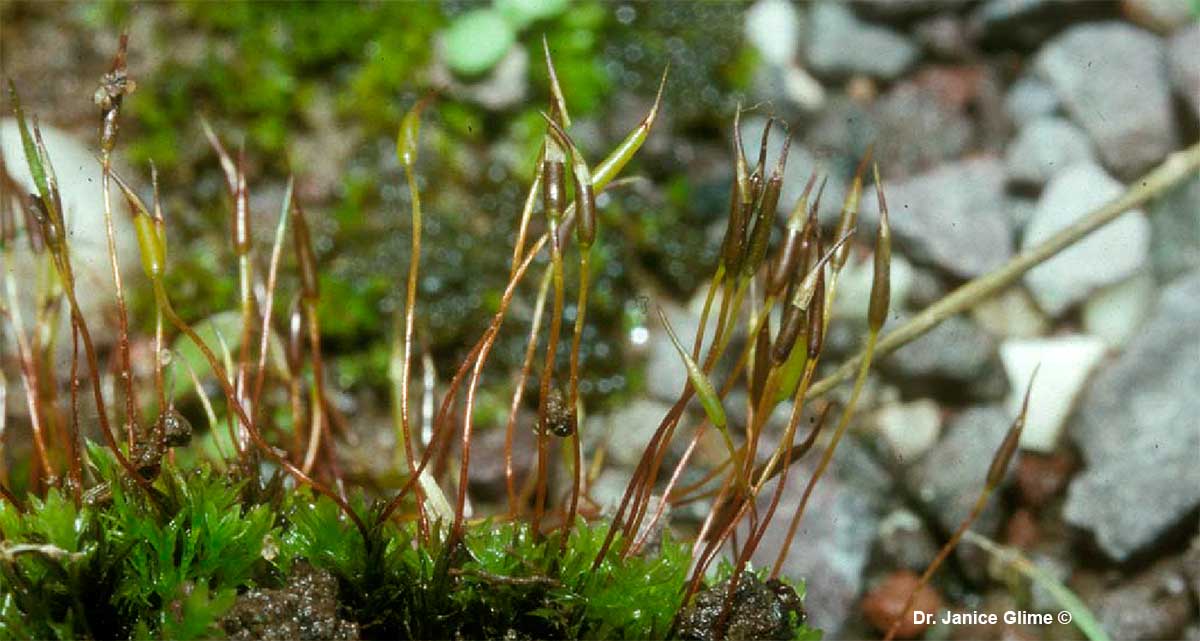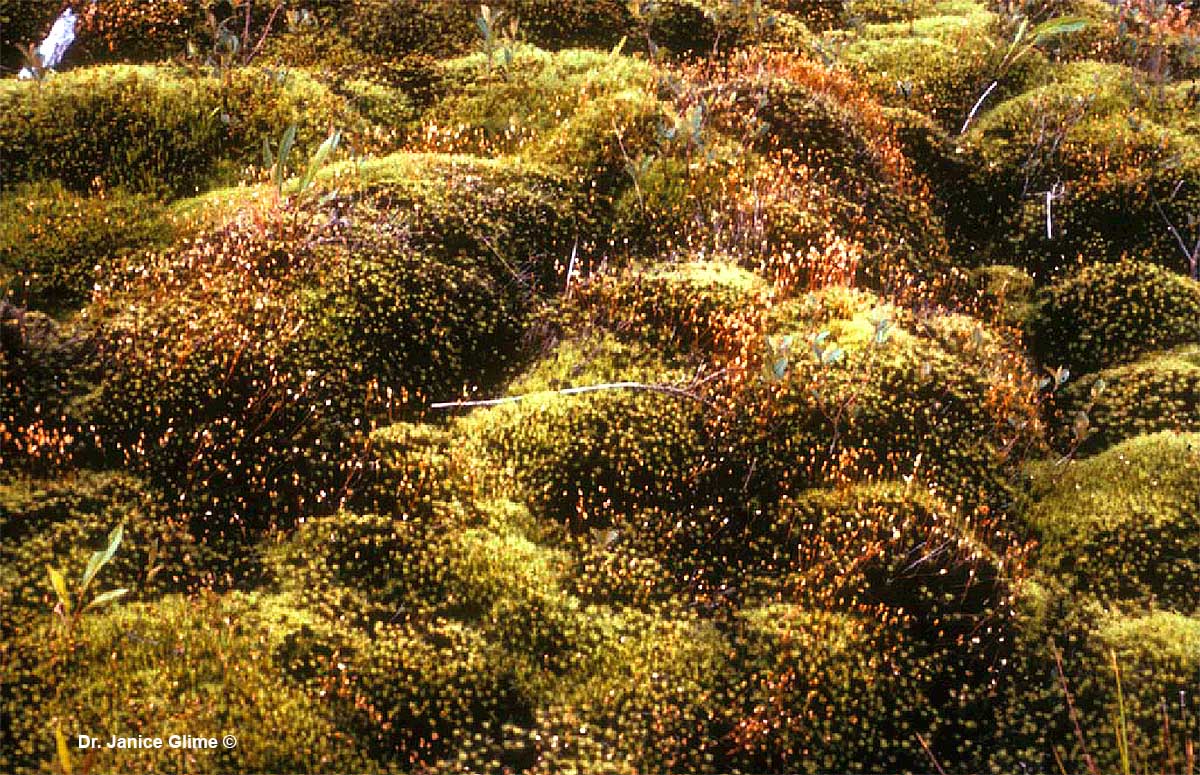
Bryophyte Ecology
by Dr Janice Glime
February 13, 2018

Bryophytes, forming their own communities on a microscale.
Bryology (from Greek bryon, a moss, a liverwort) is the branch of botany concerned with the scientific study of bryophytes (mosses, liverworts, and hornworts). Bryologists are people who have an active interest in observing, recording, classifying or researching bryophytes (Wikipedia).

"The beauty there is in moss must be considered from the holiest, quietest nook, " Henry David Thoreau 1842
I have always liked miniature things. When I was three, I wanted an electric train for Christmas. I must have been careless and only asked for a train, because I got a wooden train. I loved playing with a dollhouse. I was more interested in insects than dogs or cats. But my interest in mosses began when I took a botany course in college. My teacher couldn't answer my questions about the bryophytes. A little research of my own indicated that at that time we didn’t know much about them.

Polytrichum commune moss
When I started on my M.S. research, I intended to document the flowering plant flora at the Girl Scout camp where I was working in the summers. I wasn't at it long when I became interested in the bryophytes and instead documented them. The only book available to me was Conard's How to Know the Mosses and Liverworts. I was still too naïve to know that I could make slides of the herbarium specimens to compare with mine. But while I was working on that degree, I joined my friend and later roommate in her fieldwork. She was studying aquatic insects, and I loved streams. Soon we both realized that there were more insects among the mosses, especially Fontinalis, than in other stream habitats.

Sphagnum papillosum with capsules.
By the time I was nearing completion of my Master's degree, I was hooked. I looked for an advisor and school where I could continue my exploration of the insect communities on aquatic bryophytes. But I was a botanist, and my love of plants never waivered. Bryophytes themselves became my passion. From there I tried to answer the question of why they lived where they did. This took me into physiology of the bryophytes, and I tested their limits of tolerance to light, temperature, and nutrients. As I advised graduate students of my own, I expanded into other habitats and kept asking ecological questions.

Vegetative characters of Sphagnum, Class Sphagnopsida. upper left: Sphagnum wulfianum capitula; upper right: cross section of stem showing hyaline cells and "woody strand;" middle left: leaf showing pattern of hyaline and photosynthetic cells illuminated by UV light; red areas indicate chlorophyll fluorescence; middle right: portion of leaf showing photosynthetic and hyaline cells (note fibrillae on hyaline cells); lower left: cross section of leaf showing hyaline cells that nearly enclose the photosynthetic cells; lower right: methylene-blue-stained portion of leaf showing pores in hyaline cells.

Left: Spagnum fimbriatum showing capitulum where archegonia will arise. Right: Sphagnum girgensohnii

Left: Protonemata of the moss Plagiomnium sp. Right: Polytrichum ohioense females show lack of any special structures at the stem tips, but tight leaves looking somewhat budlike.
Tony Smith published the only (and excellent) book on bryophyte ecology, but that was in 1982. More has been published on bryophyte ecology since its publication than in all history before that. It was time for an update! And it was a good retirement project. I decided to publish it online to make it available to all the teachers, naturalists, foresters, and hobbyists who would not pay the high pricetag that my envisioned book would require. I have tried to write it to be readable for a wide range of backgrounds. Fortunately, I like to write.
About the Book - Bryophyte Ecology
For more than twenty years I have been working on a book on bryophyte ecology and was joined by Heinjo During, who has been very helpful in critiquing multiple versions of the chapters. But as the book progressed, the field of bryophyte ecology progressed faster. No chapter ever seemed to stay finished, hence the decision to publish online. Furthermore, rather than being a textbook, it will be more than three volumes.

Photomicrographs. Left: Cells of Fontinalis antipyretica showing chloroplasts in cells and embryo of embryo of the liverwort Marchantia polymorpha showing multicellar stage enclosed with the archegonium (right picture).
Throughout the book I have posed questions. I have even attempted to offer hypotheses for many of these. It is my hope that these questions and hypotheses will inspire students of all ages to attempt to answer these. Some are simple and could even be done by elementary school children. Others are suitable for undergraduate projects. And some will take lifelong work or a large team of researchers around the world. Have fun with them!
The Format
The decision to publish Bryophyte Ecology as an ebook occurred after I had a publisher, and I am sure I have not thought of all the complexities of publishing as I complete things, rather than in the order of the planned organization. But I wanted to reach a worldwide audience that included not only professional bryologists, but beginners, non-bryologist ecologists, teachers, naturalists, anyone who wanted to know something about bryophytes. Many of these people would never be willing or able to pay the cost of such a book in print copy. And the cost of the numerous color plates would be prohibitive.

Zen Iwatsuki collecting bryophyte samples in Iceland.
Some chapters have been easier for me to do and some will simply need help from others. The "book" will actually be multiple volumes, with the first being physiological ecology, but including an introduction to the broad classification of phyla and classes, morphology, structures, and life cycles. Communities, habitats, roles, interactions, and methods, among others, are in various stages of completion. Large chapters and those with many images difficult to download, so chapters are broken into smaller segments that I shall call subchapters. Sections, chapters, and subchapters will not always be posted in order, so each begins new pagination.

Left: Numbered paper bags for sample collecting Right: Small 20X and larger 10X hand lens with Nylon string to view samples in the field.
New chapters will be added as they are ready but may not cover all planned topics at the onset. Bryologists are encouraged to send me text or images for consideration, or to volunteer to write a chapter. I am considering making this like an online journal with reviewers, but that needs more planning and is likely to make style and nomenclature inconsistent. Your thoughts on the idea would be appreciated.
Learn more about Bryophytes by downloading Dr. Glime's ebooks for free below. To start photograping these plants all you need is a macro lens and tripod. A hand lens, stereoscope or light microscope will allow you to see fine detail.
Authors Biography & Contact Information
 Dr. Janice Glime is Professor Emerita in the Department of Biological Sciences at Michigan
Dr. Janice Glime is Professor Emerita in the Department of Biological Sciences at Michigan
Technological University, Houghton, Michigan, USA. She has Doctor of Philosophy in botany from Michigan State University (1968). She is past President of the International Association of Bryologists (IAB) and manager of Bryonet-L, the IAB email discussion group on bryophytes. She has published over 100 papers, is author of the book The Elfin World of Mosses and Liverworts of Isle Royale, co-author with Dinesh Saxena of Uses of Bryophytes, and editor of Methods in Bryology. Her primary research interests are on aquatic bryophytes and on the interactions of bryophytes with other organisms.
Download Bryophyte Ecology - Vol I - each chapter is a PDF - Free
Download Bryophtye Ecology - Vol 2 - Fauna and Invertebrates - PDF - Free
Download Bryophytye Ecology - Vol 3 - Methods
- PDF - Free
Download Bryopyte Ecology - (2 Vols?) - habitats and ecological principles - coming Soon
Download Bryophyte Ecology - Vol 5 - Uses of Bryophytes - PDF- Free
Some recent publications
Glime, J. M. 2014. Adventures with Stream Mosses – A Fontinalis Point of View. Effects on Growth. Evansia 31: 75-84.
Glime, J. M. 2014. Adventures with Stream Mosses— A Fontinalis Point of View. Part II: Reproduction. Evansia 31: 114-120.
Glime, J. M. 2015. Adventures with Stream Mosses — A Fontinalis Point of View Part III: Surviving the Flow. Evansia 32: 1-9.
Glime, J. M. 2014. Photosynthesis in aquatic bryophytes. In: Hanson, D. T. and Rice, S. K. (eds.). Photosynthesis in Bryophytes and Early Land Plants. Advances in Photosynthesis and Respiration 37. Springer, New York, pp. 201-231.
Kubásek, J., Hájek, T., and Glime, J. M. 2014. Bryophyte photosynthesis in sunflecks: Greater relative induction rate than in tracheophytes. Journal of Bryology 36: 110-117.
Email at: jmglime@mtu.edu
Website: Michigan Tech & Recent publications
Click on the buttons below and share this site with your friends